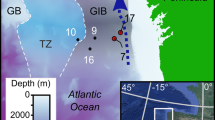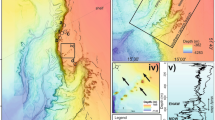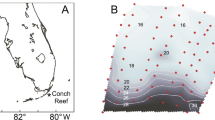Abstract
Geological and physical studies of seamounts have suggested the existence of distinct deep-sea habitats, characterized by exposed rocky bottom and a unique current regime1–9. However, few biological data have been collected for deep seamounts10–12. Here we present some of the first quantitative observations of hard-bottom (non-hydrothermal) fauna in the deep sea. These observations show that black corals (antipatharians) and horny corals (gorgonians) present on the slopes of a multi-peaked seamount are more abundant near peaks, compared with mid-slope sites at corresponding depths. On narrow peaks corals are most abundant on the crest, whereas on wide peaks, coral densities are highest at the edge of the crest. The abundance of corals also increases on knobs and pinnacles. Physical models and observations2,4–9,13–15, together with our direct measurements, suggest that the seamount topography affects the local current regime. Corals appear to benefit from flow acceleration, and some of their patterns of distribution can be explained by current conditions. These results suggest that suspension feeders have some potential as indicators of prevailing currents at deep hard-bottom sites.
This is a preview of subscription content, access via your institution
Access options
Subscribe to this journal
Receive 51 print issues and online access
$199.00 per year
only $3.90 per issue
Buy this article
- Purchase on Springer Link
- Instant access to full article PDF
Prices may be subject to local taxes which are calculated during checkout
Similar content being viewed by others
References
Lonsdale, P., Normark, W. R. & Newman, W. A. Bull. geol. Soc. Am. 83, 289–315 (1972).
Hogg, N. G. J. Fluid Mech. 58, 517–537 (1973).
Roberts, D. G., Hogg, N. G., Bishop, D. G. & Flewellen, C. G. Deep-Sea Res. 21, 175–184 (1974).
Huppert, H. E. J. Fluid Mech. 67, 397–412 (1975).
Huppert, H. E. & Bryan, K. Deep Sea Res. 23, 655–679 (1976).
Owens, W. B. & Hogg, N. G. Deep Sea Res. 27, 1029–1045 (1980).
Gould, W. J., Hendry, R. & Huppert, H. E. Deep-Sea Res. 28, 409–440 (1981).
Ericksen, C. J. geophys. Res. 87, 525–538 (1982).
Roden, G. I. & Taft, B. A. J. geophys. Res. 90, 839–856 (1985).
Pratt, R. M. in Deep-Sea Photography (ed. Hersey, J. B.) 145–158 (Johns Hopkins University Press, Baltimore, 1967).
Raymore, P. A. Pacif. Sci. 36, 15–34 (1982).
Grigg, R. W. Mar. Ecol. 5, 57–74 (1984).
Genin, A. & Boehlert, G. W. J. mar. Res. 43, 907–924 (1985).
Genin, A., Boehlert, G. W. & Lonsdale, P. F. Eos 65, 969 (1984).
Fukasawa, M. & Nagata, Y. J. oceanogr. Soc. Japan. 34, 41–49 (1978).
Sebens, K. P. Proc. natn. Acad. Sci. U.S.A. 81, 5473–5477 (1984).
Pequegnat, W. E. Ecology 45, 272–283 (1964).
Grigg, R. W. & Maragos, J. E. Ecology 55, 387–395 (1974).
Reid, J. L. Jr Intermediate Waters of the Pacific Ocean (Johns Hopkins University Press, Baltimore, 1965).
Spiess, F. N. & Tyce, R. C. Scripps Instn. Oceanogr. Ref. 73–74 (1973).
Sara, M. & Vacelet, T. Traite de Zool 3, 462–576 (1973).
Loya, Y. Bull. mar. Sci. 26, 450–466 (1976).
Wunsch, C. J. Fluid Mech. 35, 131–144 (1969).
Cacchione, D. & Wunsch, C. J. Fluid Mech. 66, 223–239 (1974).
Author information
Authors and Affiliations
Rights and permissions
About this article
Cite this article
Genin, A., Dayton, P., Lonsdale, P. et al. Corals on seamount peaks provide evidence of current acceleration over deep-sea topography. Nature 322, 59–61 (1986). https://doi.org/10.1038/322059a0
Received:
Accepted:
Issue Date:
DOI: https://doi.org/10.1038/322059a0
This article is cited by
-
Cold-water coral framework architecture is selectively shaped by bottom current flow
Coral Reefs (2023)
-
New strategies for the new environment in Spitsbergen fjords (Arctic). Scattering of the feather star Heliometra glacialis (Echinodermata, unstalked crinoid) clinging to a crab
Polar Biology (2023)
-
Population genetic structure of the deep-sea precious red coral Hemicorallium laauense along the Hawaiian Ridge
Marine Biology (2023)
-
Habitat types and megabenthos composition from three sponge-dominated high-Arctic seamounts
Scientific Reports (2022)
-
Observation of physical oceanography at the Y3 seamount (Yap Arc) in winter 2014
Journal of Oceanology and Limnology (2022)
Comments
By submitting a comment you agree to abide by our Terms and Community Guidelines. If you find something abusive or that does not comply with our terms or guidelines please flag it as inappropriate.



